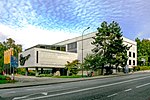Russian Church, Geneva
19th-century Russian Orthodox church buildingsChurches completed in 1863Churches in GenevaEastern Orthodoxy in SwitzerlandRussian Orthodox church buildings ... and 1 more
Russian Revival architecture

The Russian Church, Geneva (French: Cathédrale de l'Exaltation de la Sainte Croix, Cathedral of the Exaltation of the Holy Cross) is a historic Russian Orthodox church in Geneva, Switzerland. Grand Duchess Anna Fyodorovna, who resided in Bern and Geneva after she chose to separate from Grand Duke Constantine, gave funds to build the church in 1863. It was designed by David Grimm of the Imperial Academy of Arts and completed in 1866 in the fashionable Les Tranchées neighborhood of Geneva. The Russian revival church, with its Byzantine striped arches and gold onion domes, underwent restoration in 1966. The church remains in active use.
Excerpt from the Wikipedia article Russian Church, Geneva (License: CC BY-SA 3.0, Authors, Images).Russian Church, Geneva
Rue Rodolphe-Toepffer, Geneva Cité
Geographical coordinates (GPS) Address External links Nearby Places Show on map
Geographical coordinates (GPS)
| Latitude | Longitude |
|---|---|
| N 46.198882 ° | E 6.153785 ° |
Address
Église Russe
Rue Rodolphe-Toepffer 9
1207 Geneva, Cité
Geneva, Switzerland
Open on Google Maps









